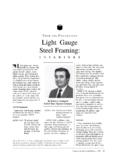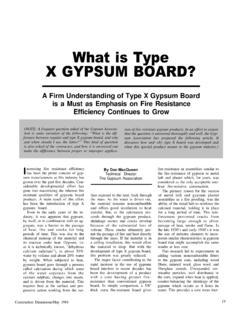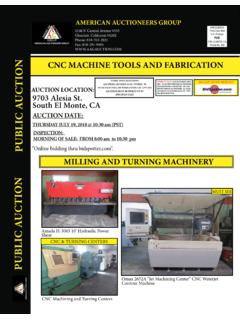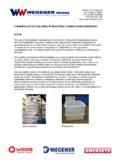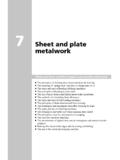Transcription of Light Gage Steel Framing Fabrication Guide - AWCI
1 BULLETIN NUMBER 161 Light GAGESTEEL FRAMINGFABRICATION GUIDECONTENTSPage NumberHandling and Transportation2 Shop Layout and Fixtures3 Cutting4 Welding5 Other Fastening Systems6 Erection7 Light gage structural Steel Framing has become increasingly popular with architects and structural engineers be-cause of its high strength, low weight, non-combustibility, dimensional stability and flexibility in Fabrication and erec-tion. It can be used both as the main structural system for low rise buildings, and as the back-up for many particular advantage is its adaptability to job and site conditions. Prefabrication into panels can be accomplishedeither at the job site or the contractor s shop; and, of course, traditional piece-by-piece construction is readily better, all of this is possible without recourse to expensive additional considerable information on Steel Framing Fabrication is available from manufacturers and suppliers, theMetal Lath/ Steel Framing Association has long felt the need to bring this together in more useful and basic form.
2 Thisdocument prepared by the Association s Technical Committee has been designed to meet that need. While it isprimarily directed at the contractor, particularly those who are considering entry into the field, we hope that it will beof equal use to already active contractors and to architects and structural engineers. We invite comments from thewhole building Framing normally can be handled and transported4. Completed panels are moved to a staging area orwithout expensive equipment. A forklift and flat bed truckloaded directly onto trucks. Depending on panel sizewill usually weight, either manpower or overhead cranes willbe used for MATERIAL ARRIVAL:III.
3 TRANSPORTATION:A. Truck is assumed that job requirements call for a full truckload of material. The delivering carrier whether a com-mon carrier, a Steel hauler, or the Framing manufacturer will probably use a flat bed truck or material will be either bundled or palletized. Palletswill generally be approximately 2' wide x 2' high x thelength of the material (from 8' long to a maximum of 40 ).Weight will generally not exceed 4,000 forklift can handle most unloading jobs quite spreader-beam with end slings can also be used with acrane, which can be any size from a small cherry-picker to a50-ton mobile (if one is on the job and advance arrange-ments for its use are made).
4 A. material is unloaded at the job-site, further trans-porting is rarely material must be moved from the shopto the job-site. The distance is generally short; however, itcan vary from a few miles to Drayage helping to arrive at a decision as to what transportingequipment will be needed, the following seven factorsshould be carefully considered and evaluated:1. Panel finish:Instead of a crane, some shops may have an overheadbridge crane or monorail available. A sideloader may alsobe used instead of a If the panel is free of collateral materials (insula-tion, metal lath and plaster, etc.)
5 , it can be easilytransported flat. If not, vertical shipment is usuallycalled MATERIAL HANDLING:A. At the the material is unloaded, it can be spotted convenient-ly around the (frame only) panels are obviously not asdelicate as those with a finish on one side. They can bereadily handled and transported without extra precau-tions, and more panels can be loaded and moved at If the structure is single story on a concrete slab, thematerial can be located approximately where it willbe If the building is going to be two to four stories high,the material for the upper floors can be stackedaround the building where it will be used later, floorby semi-finished panel will require more care in load-ing, blocking, tying down, unloading, and erecting.
6 Dif-ficult site conditions may justify the extra expenditure forthis type of Transporting distance:a. Short haul (0-50 miles)The ideal distance. Few problems should be For curtainwall applications, mid- or high-rise, it canbe hoisted to its appropriate floor by the boom crane,or taken up the freight or construction elevator. Asmall dollie or wagon may be required to get thematerial from the elevator to its usage material will be either job-site fabricated intopanels, or installed a piece at a time. In either event, specialequipment is usually not Medium haul (50-100 miles)Can be practical if the project is large and existingshop space is panelized on a slab or floor, the panels can be tilted intoplace by hand.
7 If the panels are oversize, or have to be at-tached to outside supports, a portable crane may be for low-rise buildings can be hoisted into place by aforklift with extendable forks, or lifted by a small boom(cherry-picker).c. Long haul (100 + miles)Usually not practical, particularly if the loads areover-sized (see 3 & 4 below), or the job-to-shoproute is through a congested urban area. A longhaul through a rural or suburban area, on the otherhand, may be Panel size:a. 8' high x X' long (single story or in-fill curtainwall;floor to beam, column to column).b. 8' wide x X' high (3 story curtainwall by-pass).
8 C. 8' wide (standard truck bed).d. Oversize panels may require In the Permits (check local and state regulations):Material that goes to a shop is either going to be cut tolength or fabricated. Assuming the materialwill be panelized,it can be spotted in the Fabrication area while to 8' no problem8' to 10' permit only ($15 to $50, depending onstate).HANDLING AND either case, the material can be moved from thestorage area to the saw by a forklift or an feed into a saw is generally from a conveyor,roller type stands, or table. The cut lengths continuefrom the saw on roller stands and can be stockpiledon material wagons.
9 Movement to the wagons will beby Wagons are then moved to the assembly area, consist-ing of table top jigs, where the cut pieces are fabri-cated into panels. Again, handling is by ' to 12' permit plus lead ' to 14' permit plus lead and tail car(Freight rate approx. 200% of normal).OverlengthUp to 4' permissible with red 4' permit plus additional tail lightsOverheightUp to 13' or 14' (from ground) permissible depend-ing on 13' or 14' requires permit and careful routeselection to avoid most RestrictionsAll permits are limited from dawn to dusk, noweekends, no Weight of the panels:a.
10 Not usually prohibitive since a Steel framed panel(unfinished) will weigh only around 2 pounds persq. Volumetric space is usually filled before weightlimitations are Number of trips:If a large number of trips or oversized loads are re-quired through a congested area, the freight expensemay be prohibitive and job-site Fabrication should Job-site conditions:a. Ample space panels could be delivered and stockpiled in advance of Restricted space panels may have to be erectedoff the truck as they are Vehicle selection:Once an evaluation has been made to satisfy the con-siderations covered in C above, and depending on availableequipment, the actual vehicle will fall into one of the fol-lowing categories:1.
